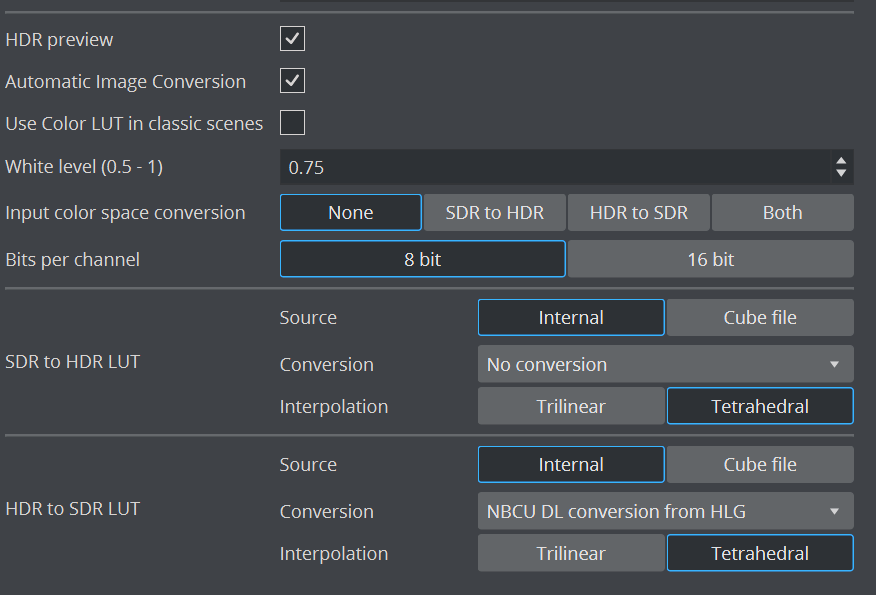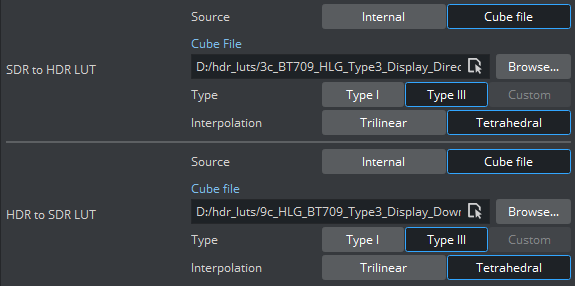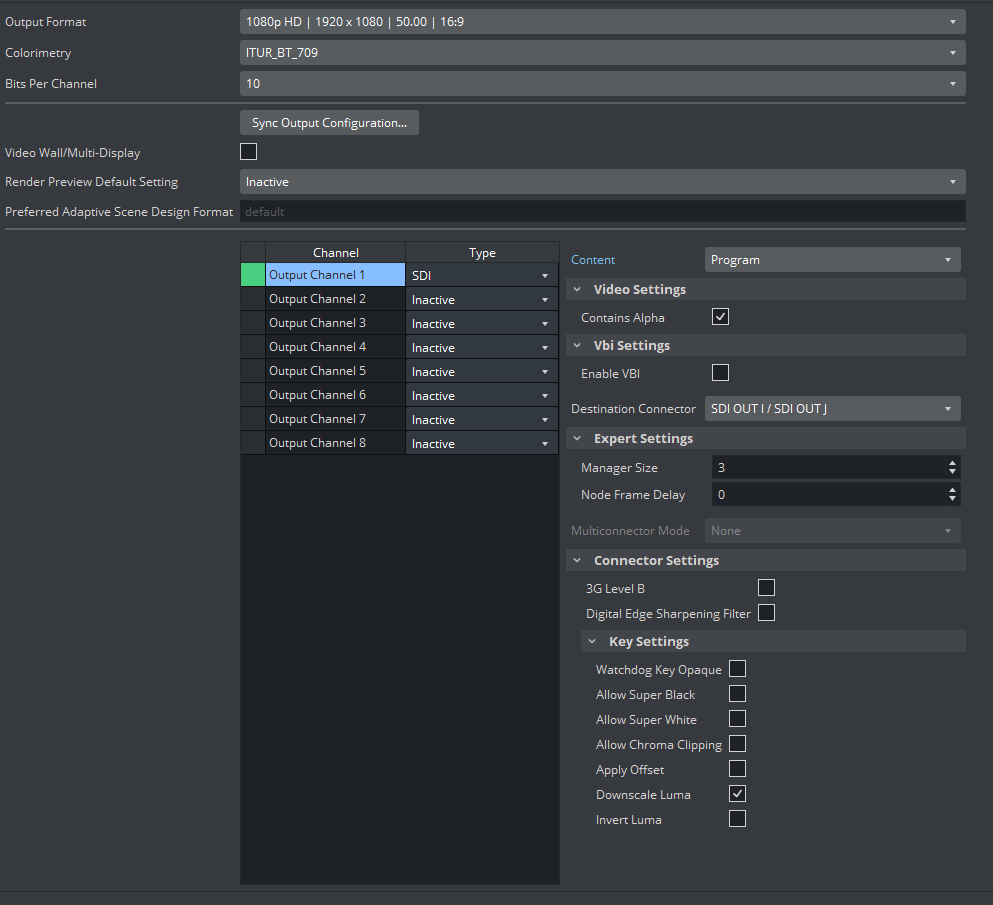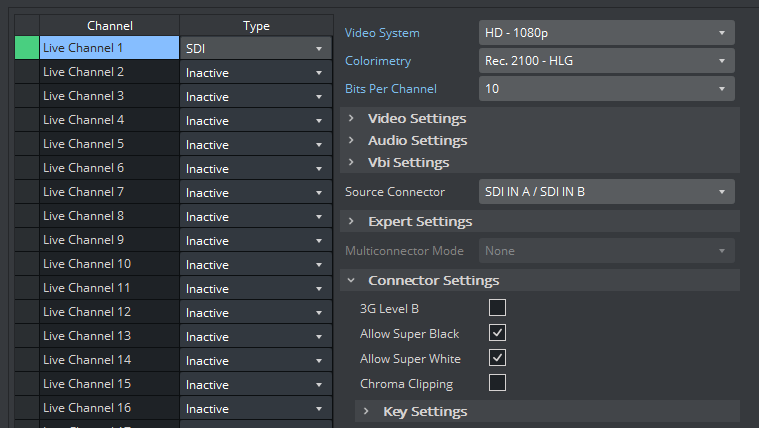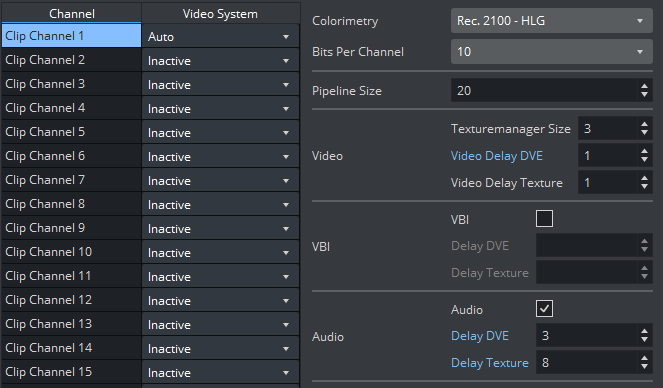High Dynamic Range (HDR), often in combination with wide color gamut (WCG), is a way to improve the colors shown on screens. This page explains which environments support HDR, and which Viz Engine configuration settings are required.
Note: Most settings and functionalities described, assume that HLG is used as an HDR format. Check the support for S-Log3.
HDR is supported with Matrox SDI or IP boards, and with software I/O mode NDI. The HDR preview on desktop monitors can be used with VGA engine versions as well. Please refer to the Viz Artist User Guide for additional information on HDR previews, and an overview of HDR use cases.
How to Configure HDR
HDR affects multiple aspects of Viz Engine configuration. Important settings can be found in the Render Options, Video Output, Video Input, and Clip Input.
Render Options
General Settings
HDR preview: Enables the OS support for HDR preview windows.
Automatic Image Conversion: Viz Engine tries to adjust the color space for any image source.
Use Color LUT in classic scenes: Enable this setting if the engine output is HDR, and classic scenes are being used. Viz Engine pipeline automatically handles this.
White Level: Used to scale between the linear scene color space, and the output HLG signal. The scene light value 1.0 is scaled to the white level on the HLG output. The default value is 75%. 100% white selected in sRGB in the color picker, is scaled to the same value.
Input color space conversion: If enabled, Live and Clip input textures are converted between SDR and HDR. The renderer then picks the appropriate version of the texture, depending on where it is used. It is recommended to use Both, for any setup with HDR.
Bits per channel: Using 16 bits per channel avoids banding.
Color Conversion LUTs
Viz Engine uses lookup tables (LUTs) to convert between SDR and HDR. Some LUTs are built-in, while LUTs from third parties can be imported from cube files. For most workflows two LUTs are required, one to convert from SDR to HDR, and another to convert from HDR to SDR. Using a matching pair of LUTs reduces round trip conversion losses.
Interpolation: Lookup tables contain the converted colors for a relatively small set of input colors. For other colors, the output is interpolated. Trilinear and tetrahedral interpolation are two different mathematical approaches. Tetrahedral interpolation is generally recommended, especially for HDR to SDR conversions.
Built-in LUTs
There are three built-in LUTs: An SDR to HDR conversion based on ITU BT.2048-8, and a pair of LUTs developed by NBCUniversal Media, LLC. All three encode display light conversions between SDR and HLG, and support extended video range.
External LUTs
HDR conversion LUTs are available from several third parties, notably the BBC and NBCU. To import an external LUT, select Cube file as the Source, and set the file path.
The BBC established a nomenclature of different LUT types, depending on the processing range. Viz Engine supports Type I LUTs (which are limited to nominal range), and Type III LUTs (which support extended range). Configure the type that matches the used cube file.
Video Configuration
Video Output
HDR is supported in 1080p or higher.
Set the output colorimetry to HLG or S-Log3.
Use 10 bits per channel to avoid banding.
Enable Allow Super Black and Super White, to enable extended range video signals.
Live Inputs
Configure the resolution, frame rate, and colorimetry of the input signal.
It is recommended to use at least 10 bits per channel.
Clip inputs
Similar to live configuration, select the format and colorimetry of the clips that should be used in the channel. The Matrox clip player assumes that any loaded clip has the configured colorimetry, while VML uses the metadata of the clip. Using 10 bits per channel is recommended.
NDI Additional Information
HDR is fully supported with NDI, but there are a few details to consider:
Only the program NDI output in software I/O Mode NDI supports HDR.
NDI HDR inputs are supported with both Software I/O Mode NDI and Matrox boards.
The colorimetry of inputs is automatically determined based on metadata in the NDI stream. Streams with missing or incorrect colorimetry metadata are interpreted as SDR.
S-Log3 Support in Viz Engine
Using S-Log3 requires a Matrox board. The only use case supported with S-Log3 is to render SDR overlays on top of S-Log3 videos or clips in the scene background. A proper SDR to S-Log3 LUT needs to be provided. These LUTs might not match Type I or Type III as described above. For a fine grained control, you can configure the settings sdr_to_hdr_lut_input_range and sdr_to_hdr_lut_output_range separately, in the config file.
